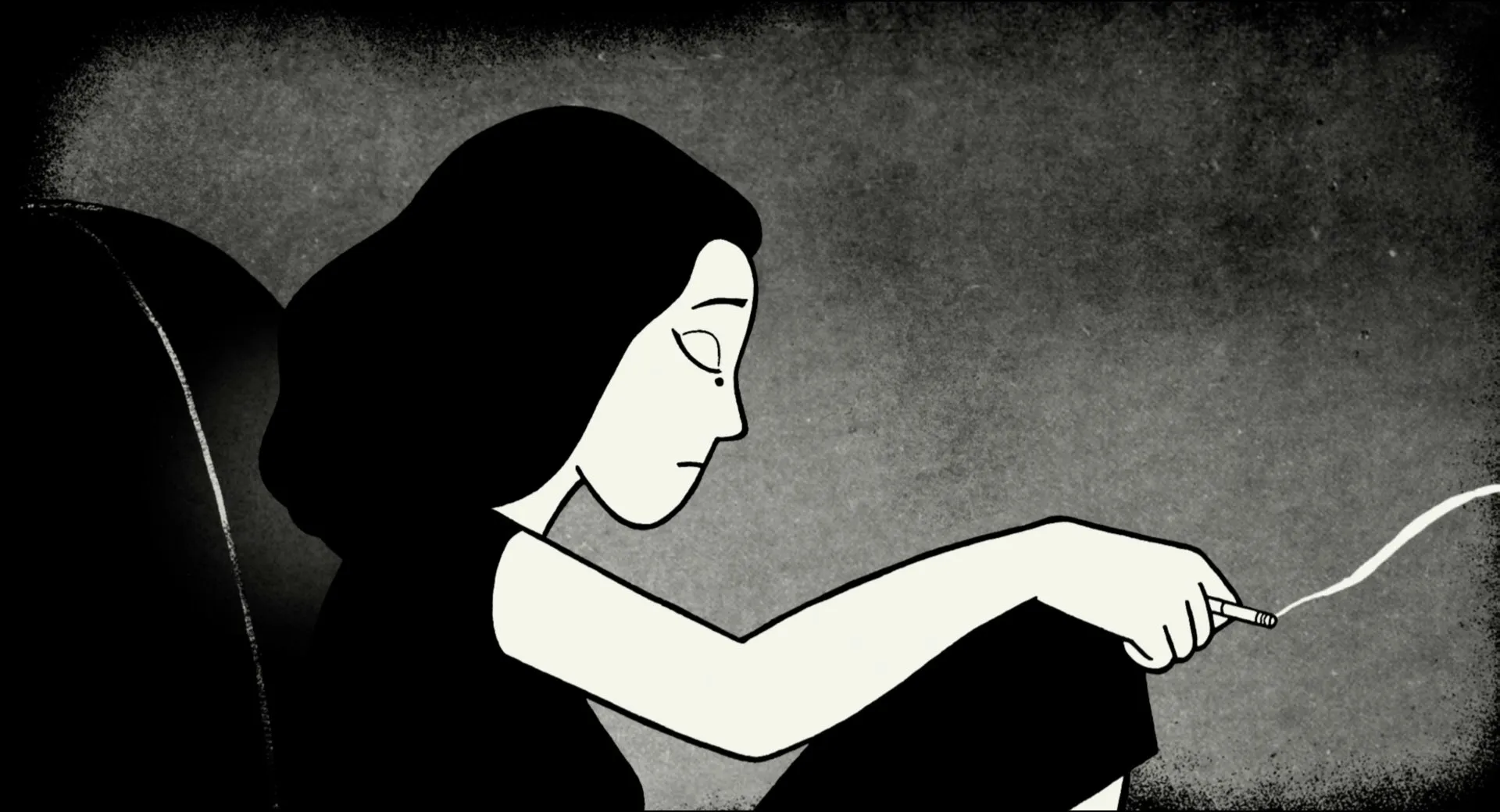Persepolis
dir. Marjane Satrapi & Vincent Paronnaud, 2007

In a 2011 article for The Guardian, artist Marjane Satrapi wrote that ‘Animation and comics are false siblings.’ Indeed, a movie cannot supersede static drawings that tell a story on paper. Satrapi states that when reading a comic, the imagination has room to supplement spaces between each panel with movement. The flow of animation does not allow for such mental wandering. Satrapi also expressed that she prefers the term ‘comic’ to ‘graphic novel’. The comic strip is a non-conformist, defiant medium that shouts anti-establishment. It is a cross-pollination of art, politics and satire in an open and democratic format — literature meant to be picked up by anybody. This accessibility lends itself to her seminal work Persepolis; one that opens conversational doors to the Middle East that might have otherwise remained shut.
An Iranian-French collaboration between Satrapi and illustrator Vincent Paronnaud, the animated Persepolis became universally celebrated for tying together the personal and political. Appreciated was its comical aspect, Satrapi’s language of storytelling and her generosity in offering deep parts of her experience to a Western audience who, until its release, may have misunderstood the true resilience of Iranian women (and people) in complex times.
Persepolis observes a young Marjane growing up in Tehran during the 1979 Iranian Revolution. It details the subsequent Iran-Iraq war and the restriction of freedoms that followed — especially for women. Split into two chapters, the narrative moves from Marjane’s childhood to an adolescence spent in Europe, and her return to Tehran as an adult. It brings to light layers of political and social context in an era that Iran is still perceived through today. Importantly it unpicks Western assumptions, in particular those made from the 1980s onwards.
Young Marjane is a girl with two obsessions: ‘Being able to shave [her] legs one day, and becoming the last prophet in the galaxy.’ She likes french fries with ketchup and her cultural icon is Bruce Lee. At night she talks philosophically with God from her bedroom. When the Shah is overthrown Marjane becomes curious about the social upheaval; soon after, anarchist Uncle Anouche comes into her life. He teaches her about Persian history and resistance to oppressive regimes — in and outside Iran — that threaten to overshadow their homeland.
The animation is the comic condensed but hits major beats of Satrapi’s biography. Perhaps one creative aspect the movie holds over the book is its voice acting; that of Marjane (in English: Amethyste Frezignac and Chiara Mastroianni), her grandmother (Gena Rowlands) and Uncle Anouche. Ordinarily importance might be placed on seeing a film in its original language — in this case, French. I first saw the English dub as a teenager, but recently learnt that Anouche is voiced by punk ‘godfather’ Iggy Pop. A memorable segment of Marjane’s teen years is sourcing bootleg (Iron Maiden) cassettes from backstreet vendors. Satrapi pulls at this thread in her casting of an infamous rebel singer to honour her hero uncle.
Marjane’s childhood is marked by the horrors of impending war and enforcement of a harsh regime intended to quash dissent. After the execution of Anouche by the state, and defying a dogmatic school teacher, she’s sent to Vienna by her concerned parents. Her father encourages her to engage in freedoms of Western living and Austrian delights — including the famous chocolate cake, Sacher-Torte. But, Marjane’s excursion to Europe is far from transformative. She’s pushed from friends’ houses, to Catholic boarding school, to friends-of-friends’, until she lands on the streets. Later, while homeless, Marjane sees the cake behind a bakery window. Staring through the pane and penniless, she turns and treads sorrowfully into the winter night.
Unanchored and adrift, Marjane suffers in Europe. Her displacement is compounded by existing apart from loved ones enduring subjugation. As an outsider, sharing her experience ignites the wick of political awareness and cultural sensitivity in uninformed minds. Marjane’s Viennese group of friends are shallow activists who, between live alternative music and passing joints, make vague gestures at philosophical and societal understanding. One of them utters a vacant statement about complacency and antipathy being honest paths to political enlightenment. In her defiance Marjane reminds them that privileges taken for granted here are not enjoyed everywhere by all.
In 1992, after being hospitalised, Marjane flies back to Tehran. Unable to cope with the dissonance of returning to an oppressive state after her stint in Austria, she sinks into depression. She salvages meaning and purpose by enrolling in art school. Marjane, her then partner Reza and friends attempt to live under crushing authority, indulging in acts of rebellion whenever they may be afforded — sometimes at great cost.
In Persepolis, profound moments of humour and strength come from Marjane’s grandmother. As with The Farewell, matriarchal figures of determination guide youth floundering in times of darkness. Oftentimes women shoulder greater burdens handed down by totalitarianism. The tone of Persepolis at once conveys bleakness and disobedience; black ink translates visually the weight of a heavy regime, but also the force of female defiance harnessed through artistic voice. Through drawing, Marjane details that standing by one’s geographical beginnings — whilst weathering political climate — is a statement of individualist and cultural pride.
Marjane’s account is bookended by her moving to Paris to live more freely than Tehran presently allows. Acknowledged is that her home country’s identity, like much of the world, is far from settled. But, when she steps out into the post-airport rain, a cab driver asks her, ‘Where are you coming from?’ With calm resolve, Marjane says: ‘Iran.’